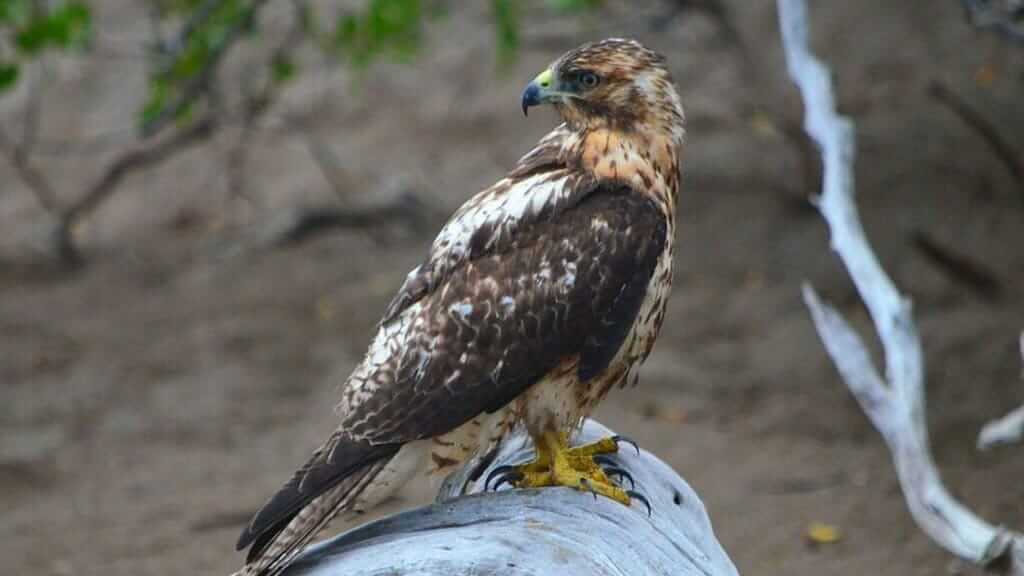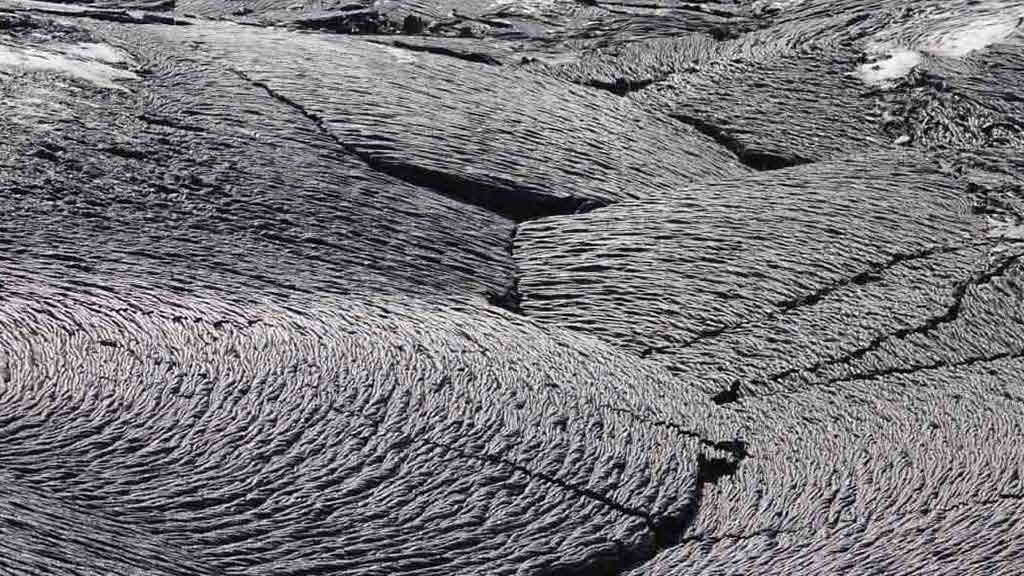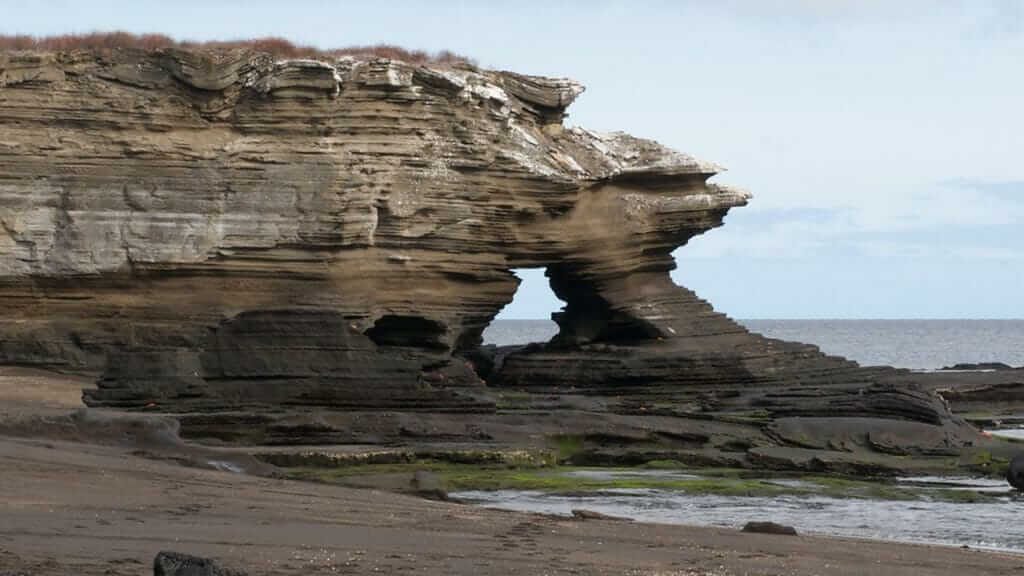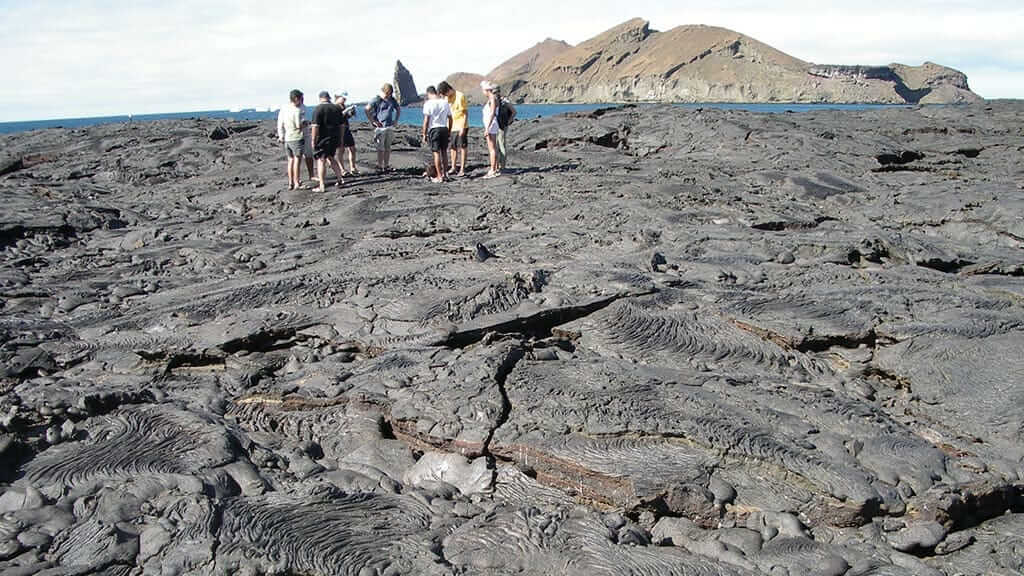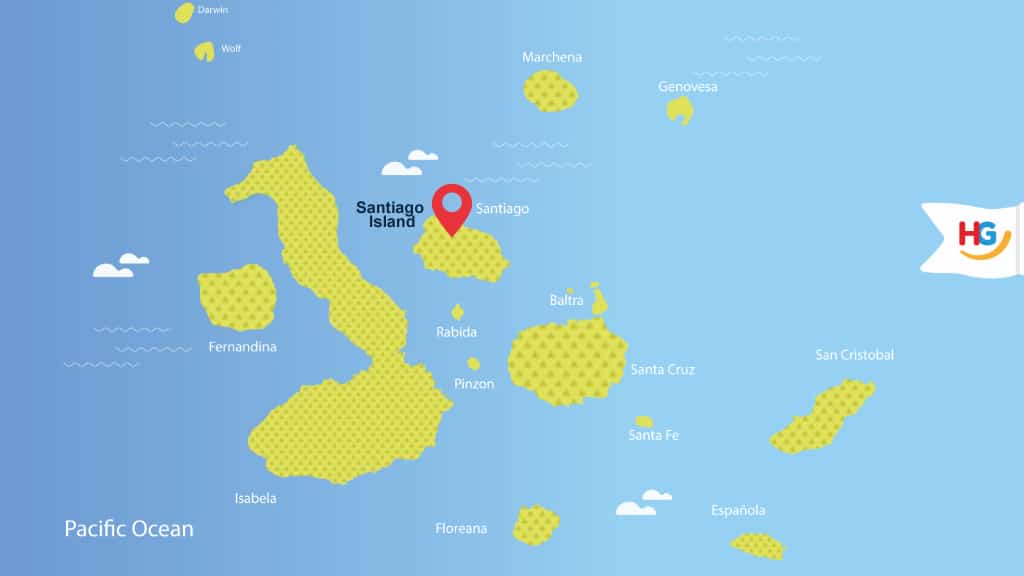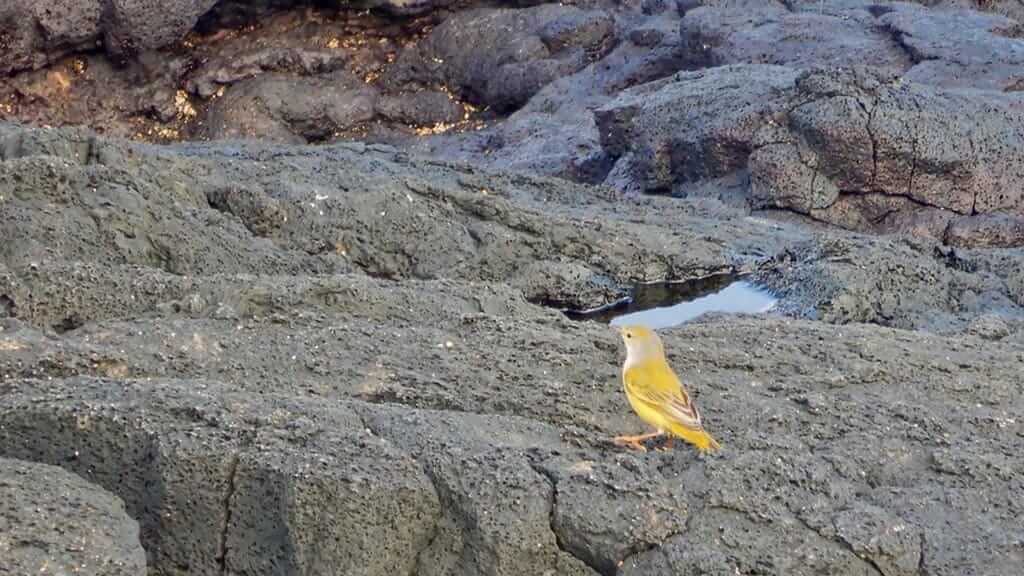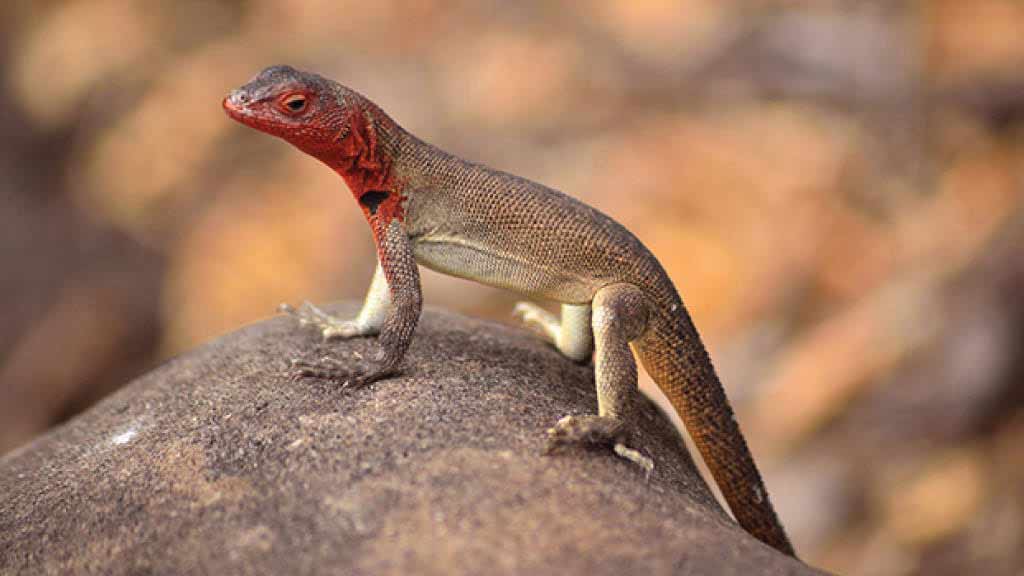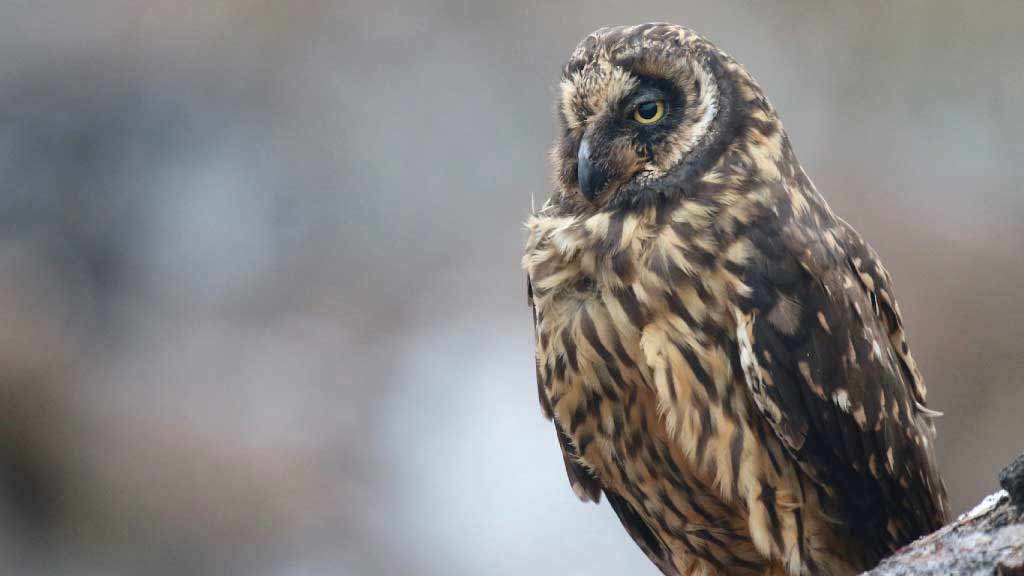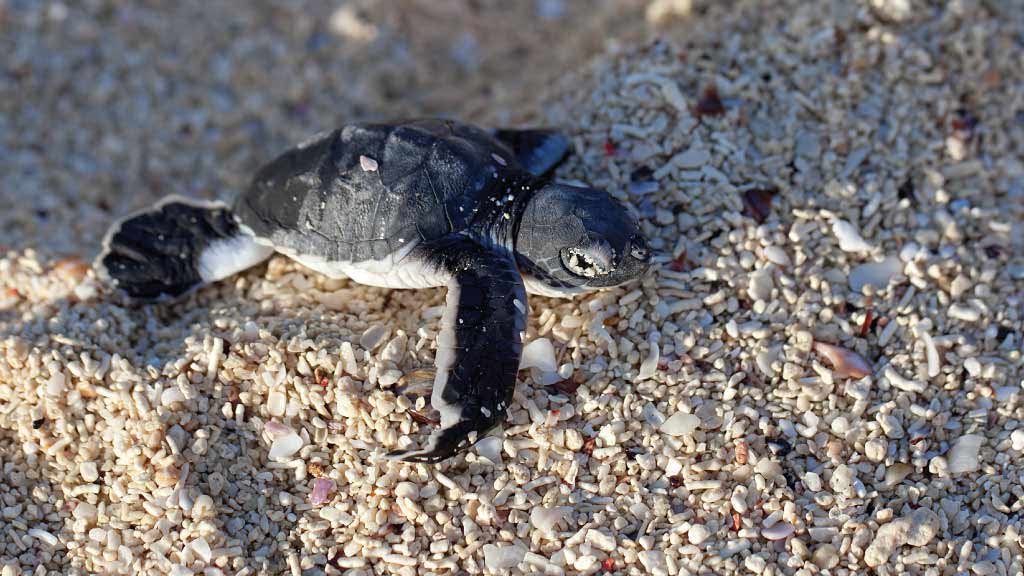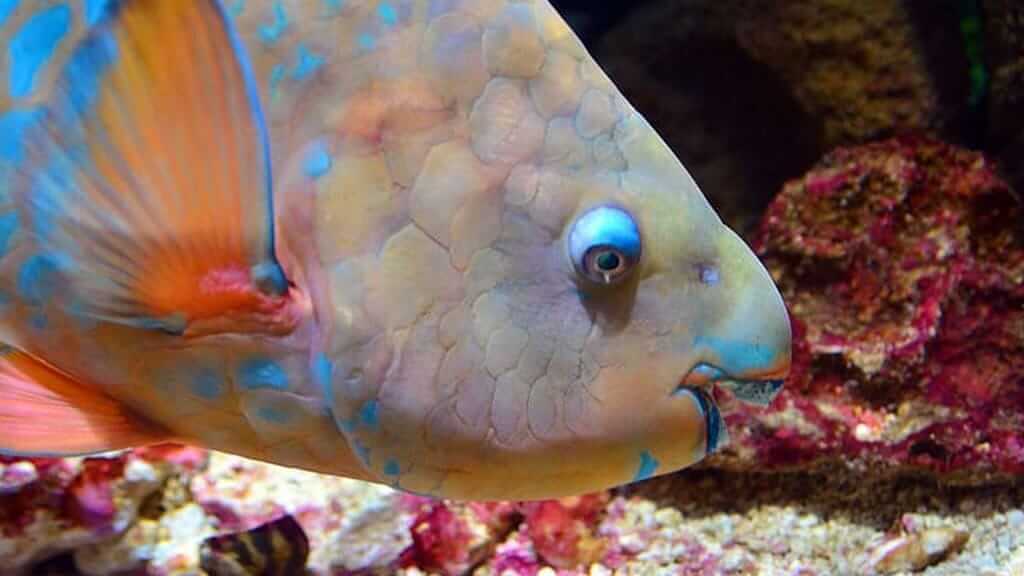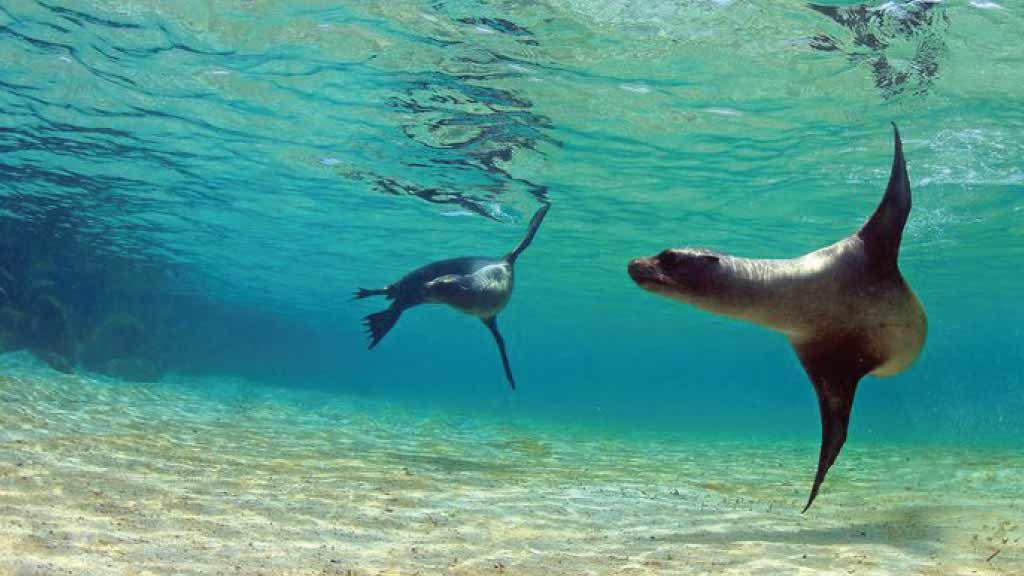Santiago Island Galapagos
Santiago Island Galapagos is one of the most interesting and diverse islands in the archipelago. For stunning volcanic landscapes, Santiago Island ticks all the right boxes. Visitors find themselves in a world of surreal black, basalt lava flows, perfect for unusual snaps to impress your friends on social media.
Santiago Island also oozes in history and has many a tall story to tell. From the ancient pirates who used Santiago as a resupply base, to the famous visit of Charles Darwin in 1835.
And let’s not forget Santiago Island’s Galapagos wildlife which is varied on land and in the ocean, including fur seals, sea turtles, and great diving.
Santiago Island Galapagos truly has something for everyone and is not difficult to visit. We highly recommend including it in your Galapagos itinerary!
Keep reading for everything you need to know to plan your visit to Santiago Island at Galapagos. What wildlife to look out for? Which activities and visitor sites await? Plus learn about the diverse history and geology of Santiago.
Santiago Island Galapagos Wildlife Highlights:
Which animals are on Santiago Island Galapagos?
• Santiago’s shady lava grottos are one of the best places to get up close to cute Galapagos Fur Seals.
• Tidal rock pools on Santiago Island are teaming with interesting marine life. Try to spot Sally Lightfoot crabs, Anenomes, and Sea Urchins clinging to the black lava. At low tide, you might also spot Octopi, Moray eels, or Reef fish.
• Galapagos shore birds are another common sight around the rock pools. Lava Herons, Ruddy Turnstones, Noddy Terns, Whimbrels, and American Oystercatchers are among the species to look out for.
• There are an incredible 7 Galapagos dive sites located around Santiago Island, including iconic Cousin Rocks and Beagle Rocks. These are right up there with the very best day dives at Galapagos. Oh, and the snorkeling is pretty awesome too!
• Santiago Island beaches are important nesting sites for Green Sea Turtles. They lay their eggs here from January onwards, with babies hatching around April/May.
• Santiago Galapagos is also home to Galapagos land birds like Darwin’s Finches, Flycatchers, and Galapagos Hawks.
About Santiago Island
English Name: James
Ecuadorian Name: Santiago
Total Area: 226 sq miles
Population: zero (uninhabited)
A visit to Santiago Island Galapagos is like a visit to another world. Surreal landscapes of black lava stretch out as far as the eye can see. These are wonderful examples of Pahoehoe lava flows. Pahoehoe is slow-moving lava with low viscosity, forming attractive ropey patterns when it solidifies. Photographers find Santiago ideal for taking abstract snaps of these unusual forms.
Santiago Island Galapagos Geology:
Santiago Island is formed by two overlapping shield volcanoes. Repeated lava flows merged the volcanos together to form the single island we see today. Shield volcanoes are flat and wide, hence the large size of Santiago island – the 4th largest island of the archipelago.
Santiago’s outstanding geological feature is the huge basaltic lava flow at Sullivan Bay. This is the largest and longest lava flow in the Galapagos! Visitors are allowed to walk on the lava to appreciate the swirls and patterns up close. The more observant among you might spot lava bubbles and petrified tree trunks.
Santiago Island Habitat:
The natural habitat of Santiago Island has been adversely affected by the presence of humans and invasive species. Hungry goats destroyed the wooded highlands, leaving the open grasslands present today.
Volcanic eruptions have left barren black lava rocks across much of the lowlands. Small plants and shrubs are only now attempting to find a foothold to colonize such infertile ground.
Rock pools and grottos formed by eroding lava are full of marine wildlife activity. So too are the steep cliffs where sea birds perch to rest while hunting for fish.
Santiago Island History:
Santiago Island has a more diverse and fascinating history than most of the Galapagos islands. Back in the 1700s and 1800s, Santiago was a popular stop-off for pirates and buccaneers in Galapagos waters. Why would pirates come to the Galapagos islands? It was a safe and handy place to hide out in between raids. Also, pirates could resupply their ships with wood, fresh food, and water. Capturing giant tortoises on Santiago Island meant that pirates could take several months of fresh food with them for the next voyage.
Santiago’s next visitor was altogether more civilized. HMS Beagle arrived on the shores of Santiago island on October 5, 1835, with a certain young naturalist named Charles Darwin aboard. Santiago was the second island that he visited (after San Cristobal), and the place that he stayed the longest. Darwin spent two entire weeks on Santiago Island, walking from coast to coast to collect his samples, and the poor old Santiago Galapagos Tortoise was once again on the menu. Darwin also made some very important biological notes while staying in Santiago. He speaks of a large colony of Land Iguanas, stating:
" I cannot give a more forcible proof of their numbers than by stating that when we were left at James (Santiago) island, we could not for some time find a free spot from their burrows on which to pitch our single tent.” (Charles Darwin, The Voyage of the Beagle) "
Why is this so significant? Throughout the 1900s there were no land iguanas to be found in Santiago. Without Darwin’s observation, we would not even know that this species had once lived there, only to become extinct. In a happy ending to this story, in 2019 the Santiago Land Iguana was successfully reintroduced to the island.
The final chapter of Santiago Island's Galapagos history takes us into the 1920s. A salt mine was established here for extraction and export. This continued into the 1960s when commercial companies took over, and roads and buildings were established at the mine site of Puerto Egas.
Where Is Santiago Island Galapagos?
How do you get to Santiago Island? Santiago is located to the north of the Galapagos archipelago. The best way to visit today is on a Galapagos cruise doing the northern itinerary loop. Cruises visit all of the visitor sites listed in this blog post.
There are also sometimes Santiago Island tours operating out of Santa Cruz, usually to Sullivan Bay combined with nearby Bartolome Island.
Contact us for a FREE GALAPAGOS TOUR QUOTE, or for more information to plan your Galapagos vacation.
Santiago Island Galapagos Visitor Sites:
Santiago Island has something for everyone. Unique landscapes, great wildlife, top snorkeling, lava hikes, coastal panga (zodiac) rides, and unforgettable scuba diving. Keep reading to learn more about each site and activity.
1. Puerto Egas Santiago (James Bay)
Landing Type: Wet.
Trail length: 1.25 miles / 2 km.
Terrain: an easy to moderate 2 and 1/2 hours trek over flat terrain. Volcanic rocks can be uneven, so take care of your footing.
This natural bay is named after Jorge Egas, who opened the nearby salt mine in the 1960s. Visitors to Puerto Egas can explore three different land trails.
The first Puerto Egas trail leads along the shore on a terrain of compacted volcanic ash and black basaltic lava. The main tourist highlight here is the Galapagos Fur Seal grottos. This is probably the best spot in the Galapagos to see fur seals close up, as they love this shady habitat. See if you can spot the difference between a fur seal and a Galapagos sea lion. The coastal trail also passes many tidal pools which are often filled with interesting marine life. Look out for wader birds and herons (lava, yellow-crowned, and great blue herons) stalking the rocks for a meal. Marine iguanas also hang out here, camouflaged against the jet-black rocks.
The second optional trek leads to the old salt mines. This is a longer hike of around 4 miles in length, leading to a volcanic crater. Here there is a saltwater lagoon, which dries into slat flats in summer. Flamingos and pintail ducks are common visitors when the brackish waters are full of tasty crustaceans.
The third and final Puerto Egas option is a trail that leads inland past another brackish lagoon with flamingos and wading birds. The path continues into the more arid habitat of palo santo trees onto ancient lava flows.
Usually, your guide will choose which of these trails that his/her group will follow.
Puerto Egas also gives visitors the opportunity for Galapagos snorkeling. The underwater action here is excellent. Highlights may include fur seals, colorful reef fish, eels, whitetip reef sharks, sea turtles, and sea horses.
2. Sullivan Bay - Santiago Galapagos
Landing Type: Wet.
Trail length: 1.5 miles / 2.5 km.
Terrain: 1 and 1/2 hours easy to moderate walk over uneven volcanic terrain. Use suitable shoes and take extra care with your footing.
Even before landing it will be apparent that Sullivan Bay is rather different than most other Galapagos visitor sites. Breathtaking black lava fields stretch out before you. This is as close as you’ll get to ancient lava flows at the Galapagos islands.
A wet landing drops visitors onto a beautiful, white coral sand beach, where lazy sea lions greet you. But we are not here to sunbathe, Sullivan Bay is all about volcanoes and lava! Amazing ropey, bubbly, spirally lava!
Your naturalist guide will lead you onto the immense Santiago Island lava field. Both ropey smooth Pahoehoe and jagged sharp Aa flows are present; your guide will be happy to show you the difference between each type. Pahoehoe lava is quite rare on planet Earth, mostly found in the Galapagos islands and in Hawaii. Keep your eyes open for small pioneer plants growing from cracks in the lava, and lava lizards scuttling around your feet. You might also come across little lava ovens that look like mini volcanoes themselves.
At the end of your trek, there’s time to snorkel from the beach where sea lions, Galapagos rays, sea turtles, and reef sharks may be spotted. These calm, shallow, and crystal clear waters are also home to a variety of colorful Galapagos reef fish, especially among the rocks and crevasses close to the lava. Occasionally, lucky visitors may also cross paths with a Galapagos penguin in the water here.
From Sullivan Bay visitors are also rewarded with lovely views of Bartolome's Pinnacle Rock across the bay, making this a good spot for some landscape photography.
3. Buccaneer Cove Santiago
Landing Type: n/a. This site is a panga (zodiac) ride.
Santiago Island's Buccaneer Cove is a place to use your imagination. Cast your mind back to times when pirates and buccaneers ruled the seas. Centuries ago this cove was their hideout, where they would take refuge from pursuit and restock the ship with food (tortoise meat) and water. This is also the site where Charles Darwin camped with land iguanas for nine days back in 1835.
Today, visitors to Buccaneer Cove take a panga (zodiac) ride along the coast. Steep red cliffs are home to hawks, owls, and sea birds like blue-footed boobies. Water and wind have combined to erode the lava into a series of caves and interestingly shaped lava formations. Fur seals and sea lions love to swim in the cove and haul themselves out to sunbathe on rocky ledges. Your guide may also let you jump into the waters to snorkel.
4. Espumilla Beach
Landing Type: Wet.
Trail length: Short 1-hour walk along the beach.
Terrain: Easy, sandy terrain.
At the northern end of Santiago's Buccaneer Cove is Espumilla Beach, an important sea turtle nesting site. Green sea turtles are the only species to breed and lay eggs inside the Galapagos Marine Reserve. They begin to arrive at this white coral beach in January each year. It's unusual to see them as they lay eggs at night to avoid the risk of predators. Tourists can easily observe their flipper tracks from the sea and the nesting sites that have been dug out on the dunes. Sea turtles begin to hatch in April and May, making a quick dash to the sea to escape the clutches of lurking land predators.
Chinese Hat (Sombrero Chino) is another popular visitor site close to Santiago island.
Santiago Island Galapagos Dive Sites
The Scuba diving action around Santiago Island proves that the Galapagos offers some of the best sites in the world for underwater adventures. Bainbridge, Beagle, and Cousin’s Rocks are classic Galapagos dive destinations where sharks, sea turtles, fur seals, hawkfish, frogfish, and sea lions swiftly move through clouds of brightly colored reef fish.
The variety of places to dive here is suitable for all levels of divers, from beginners to advanced. There are also opportunities for night dives- a rare chance to see the nightlife of the marine creatures of the archipelago.
1. Bainbridge Rocks
An iconic favorite for all levels and snorkelers and divers, Bainbridge Rocks is a collection of islets where reef fish, sea lions, fur seals, a variety of rays, and sea turtles come to feed.
The most visited of the islets is the remains of a volcanic cone jutting out of the water. In the center of the cone, a turquoise seawater lagoon attracts flocks of flamingos-wading in the shallow depths beneath the sunny blue tropical skies.
2. Cousins Rocks
Located northeast of Santiago Island, Cousins Rocks is a triangular rock standing thirty feet above the surface and a few hundred feet long. Depths underwater reach 90 feet.
Both Galapagos sharks and white-tipped sharks, sting and spotted eagle rays, sea lions and turtles, and an astonishing array of mesmerizing and colorful schools of reef fish use the area as a cleaning station. Keep an eye out for black striped Salema, hawkfish, and frogfish around the walls of black coral along the rock’s walls.
The waters of Cousin’s Rock are suitable for all levels of divers. There can be currents that prevent divers from swimming around the outcrop, but a small channel nearby alleviates the situation.
3. Beagle Rocks
A trio of rocks rising above the surface of the sea off of the southeastern coast of Santiago Island. Beagle Rocks offers adventure for all levels of divers. Depths extend to 60ft or 12 meters and light current and clear visibility make it the place to find some of the more elusive creatures of the Galapagos waters.
Hammerhead and white-tipped reef sharks, spotted and eagle rays, sea turtles, and the occasional wandering whale shark are some of the marine life that comes to feed on clouds of colorful schools of reef fish. This is one of the best day dive locations in the Galapagos! Beagle Rocks dive tours operate from the popular town of Puerto Ayora on Santa Cruz Island.
4. Albany Islet
Albany Islet, sometimes called Albany Rock, is a small island southwest of Santiago Island Galapagos where divers explore the waters of a protected cove. It is a dive for all levels of divers where light currents and depths of 100ft give way to an underwater adventure including sea lions, sea turtles, hoards of reef fish, rays, and sharks. There is a descending wall where black coral and intriguing rock formations form nooks and crannies where marine life thrives.
In conclusion, Santiago Island Galapagos is one of our favorite sites in the archipelago. We love the sense of history that Santiago Island conjures up. You can almost imagine Charles Darwin wandering around in wonder, cursing the resident land iguanas. Santiago also represents the devastation that man can cause to fragile ecosystems and the healing from conservation efforts. Today Santiago may not exactly resemble the habitat that Darwin and pirates remember, but recovery is underway. Santiago Island also demonstrates firsthand the origins of the Galapagos islands. Creation by fire, and the dramatic power of the natural world we live in. Let’s not forget the incredible marine wildlife that has made it home here. Santiago has unbelievable snorkeling and diving action, with all sorts of surprise encounters in the depths. In short, if you have the opportunity to visit Santiago island then definitely do so!!!

